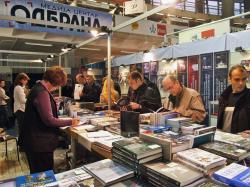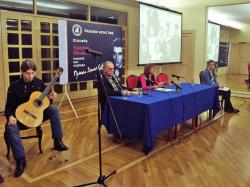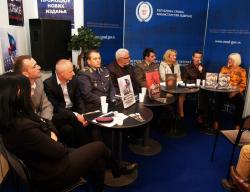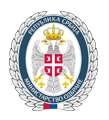- About MoD
Minister and Associates
- Minister
- State Secretary
- Assistant Ministers
- Secretary of the Ministry of Defence
Sectors
- Defence Policy Sector
- Human Resources Sector
- Material Resources Sector
- Budget and Finanance Sector
- Sector for Infrastructure and Hospitality Services
- SAF
- Documents
- Services
- Sport
- Archive
- Contacts
15.10.2011.
“White Cane Day” marked in Central Military Club
 The international day devoted to the blind and visually impaired persons – “White Cane Safety Day” was marked today in the Military Club’s Big Gallery in Belgrade by a visit to a part of the recently opened exhibition “Pavle Beljanski Collection: again in Belgrade”.
The international day devoted to the blind and visually impaired persons – “White Cane Safety Day” was marked today in the Military Club’s Big Gallery in Belgrade by a visit to a part of the recently opened exhibition “Pavle Beljanski Collection: again in Belgrade”. The tactile diagrams and audio-visual guides enabled blind and visually impaired persons to feel the beauty of the three works of art from Pavle Beljanski Memorial Collection from Novi Sad – Jefta Peric’s painting “Still nature”, Jovan Bijelic’s “A Girl with a book”, as well as Sreten Stojanovic’s sculpture “Natasa Boskovic”.
One of the blind persons who visited the exhibition was Vesna Radulovic. She said she did not expect that the exhibition would be so well suited to the people who have to “see” the works of art “by their hands”.
“It is good that there is an audio-recording, which is excellently done with many details – the colours on the paintings are nicely explained, as well as, everything that is presented on them. Without the audio-recording, it would be difficult for blind people to recognize what is presented on the tactile diagrams. By listening to it, I moved my hands over the diagram and in that way imagined the painting’s appearance”, Vesna explains her experience.
She points out that, contrary to the people who see, blind and visually impaired persons perceive the works of art differently and devote them more attention, because they need more time.
“I am glad that the guide took us through the whole exhibition from Beljanski Collection, because I am not only interested in that what is adapted for blind and visually impaired persons”, Vesna Radulovic concluded.
 Also, people who can see tried to feel the difficulty, but also the beauty and the skill of “viewing” the paintings and sculptures without seeing them. Biljana Stanojcic from Belgrade entered the world of touch and sound while blindfolded.
Also, people who can see tried to feel the difficulty, but also the beauty and the skill of “viewing” the paintings and sculptures without seeing them. Biljana Stanojcic from Belgrade entered the world of touch and sound while blindfolded.“It seems to me that I could not recognize Jefta Peric’s painting ‘Still Nature’ that well, although I have previously seen it and remembered it. It was difficult for me to ‘switch’ to a completely different sense from the one I am used to. I assume that people who do not see, can feel all the outlines under their fingers much better, because their sense of touch is more developed”, Biljana Stanojcic retells her unusual experience.
Dragana Bogdanovic from Beljanski Memorial Collection says that their goal was to reduce the difference between the people who can see and those who cannot. She adds that the tactile gallery is “viewing via touch and sound” and it is not strange that the people who can see could not completely feel the work of art. The exhibition was prepared according to the highest standards available internationally. Tiflo-paths, tactile diagrams, writings in the Braille alphabet, copy of the sculpture, as well as the audio-guide on Daisy-Flashplayers, enable, content- and shape-wise, that the painting be “seen” and “recognised”.
“We have started the project ‘Touch and Feel’ more than five year ago and it will become a part of the permanent exhibition in Novi Sad. Two things are necessary to realize everything we have imagined – handmade tactile diagrams and audio recordings. This is a pilot project where we assess everything we have done and gain new experiences. Today we are testing how blind and visually impaired persons respond, as this is the first exhibition in this region directly connected to the fine arts, which is much more difficult to evoke than sculptures” – says Dragana Bogdanovic and stresses that visitors are not used to that way of experiencing the art and more time will be needed for the improvement in that field.
 The project was realized in cooperation with the School for Primary and Secondary Education „Milan Petrovic“from Novi Sad, The Union of the Blind of Vojvodina and the Union of the Blind of Serbia, as well as the audio libraries of these organisations, with a support of the People’s Office of the President of the Republic, “Telenor” Foundation and a non-governmental organisation “Altea”.
The project was realized in cooperation with the School for Primary and Secondary Education „Milan Petrovic“from Novi Sad, The Union of the Blind of Vojvodina and the Union of the Blind of Serbia, as well as the audio libraries of these organisations, with a support of the People’s Office of the President of the Republic, “Telenor” Foundation and a non-governmental organisation “Altea”.It is estimated that there are around 12,000 blind and visually impaired persons in Serbia. The International White Cane Day is marked every October 15 since 1964, when the US Congress reached a Resolution. Apart from many public events which were organised today, the representatives of the association “White Cane” and “Berlitz School” for foreign languages walked the streets of Belgrade under the slogan – “Let’s walk together”.
- About MoD
- Jurisdiction
- Organisation scheme
- Description of duties
- Minister and Associates
- Minister
- State Secretary
- Assistant Ministers
- Secretary of the Ministry of Defence
- Sectors
- Defence Policy Sector
- Human Resources Sector
- Material Resources Sector
- Budget and Finanance Sector
- Sector for Infrastructure and Hospitality Services
- Special Internal Units
- Secretariat
- Office of the Minister of Defence
- Military Attorney's Office
- Administrative Bodies within MoD
- Defence Inspectorate
- Military Intelligence Agency
- Military Security Agency
- Autonomous Departments
- Public Relations Department
- Military Healthcare Department
- Higher Education Institution
- Defence University
- Specific internal units
- Inspector General of the Services
- Internal Audit Section
- SAF
- Documents
- Services
- Sport
- Archive
- Contacts

